Pantry cabinets are tall cabinets that require no countertop. They can be used to add tons of storage to your kitchen, perfect for storing food.
You can also use pantry cabinets in a bathroom to store linens, or in built-in. These full height cabinets come in handy when you need to add lots of storage to your space.
Things that make a pantry cabinet unique:
This post may contain affiliate links. As an Amazon Associate I earn from qualifying purchases. Click here to read my full disclosure policy.
- They are full height cabinets
- They can be as deep or deeper than base cabinets
- They do not have a countertop
Make sure to read the general how to build cabinets post here so you can see the different types of cabinets, pros and cons of each, a general overview of cabinet parts and general assembly.
In this post we will look at specific dimensions and assembly for pantry cabinets.
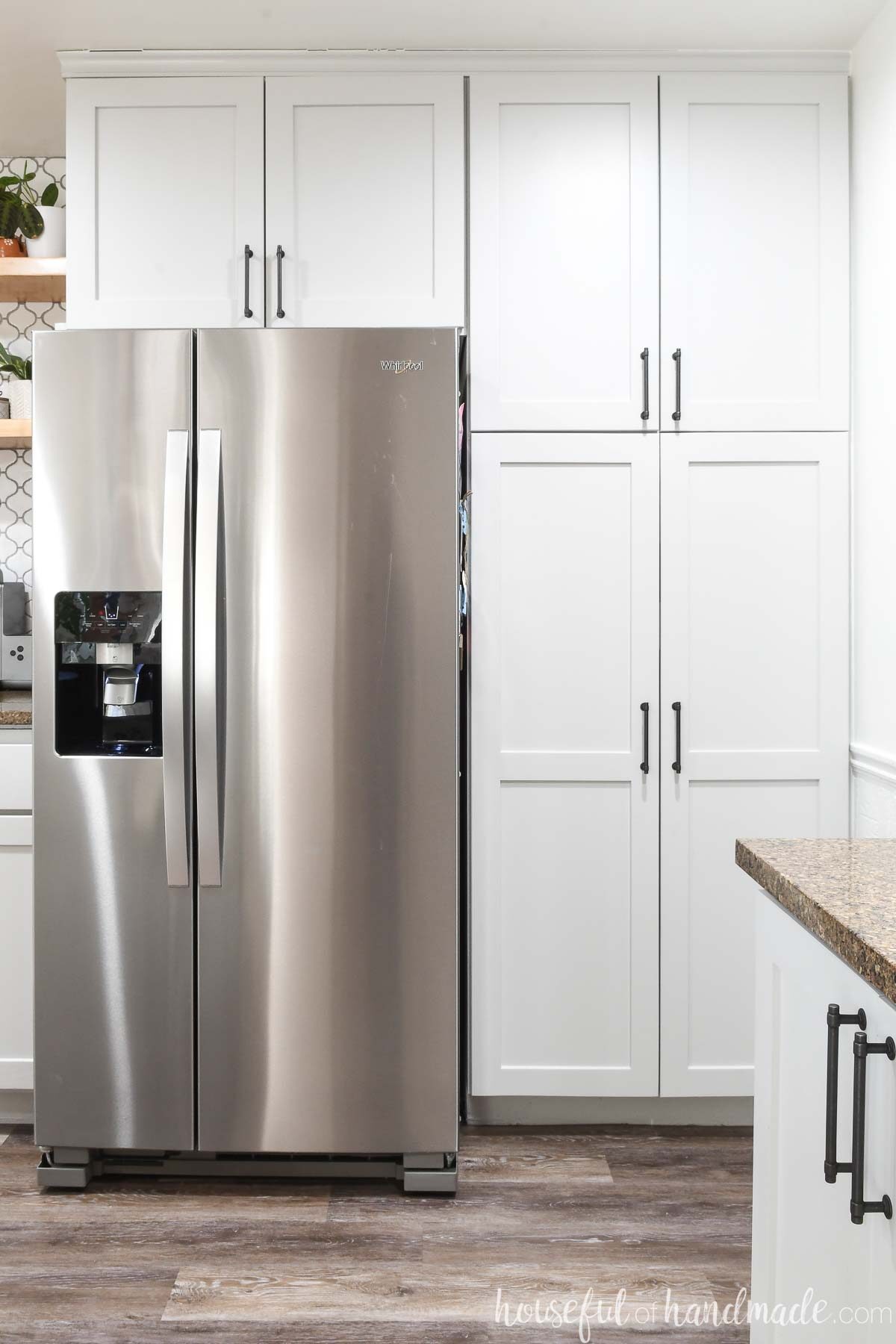
Table of contents
Things to Consider when Building Pantry Cabinets
When you are building your own pantry cabinets, you need to figure out a few things before making your cabinet plans.
Let’s look at the different options you have when building pantry cabinets so you can make some decisions.
What style of cabinet do you want?
You can build your pantry cabinet as face frame cabinets or frameless (European style) cabinets. Read all about the different types of cabinets (including pictures) here to see what type is right for you.
How tall can you build your pantry cabinet?
The tricky part of building a pantry cabinet is the height.
A single cabinet that is the full height of your wall (minus a couple inches for moulding) cannot be carried into place because the act of tipping it to stand up makes it taller than the ceiling height.
You could build the cabinet in place to prevent this, but you would have visible pocket hole screws on the inside top of the cabinet.
You can also leave more room for trim. The larger the cabinet (width and depth) the more room you will need to stand up your cabinet.
Instead, I prefer to build 2 cabinets that stack on top of each other.
The lower cabinet is the perfect place to add DIY pull out pantry drawers. And the upper cabinet can be shelves for lesser used items since it can be a stretch to reach it anyway.
With stacked cabinets for you pantry, there is no limit to how tall you make it. Just make sure you have a step stool close by so you can utilize the top shelves.
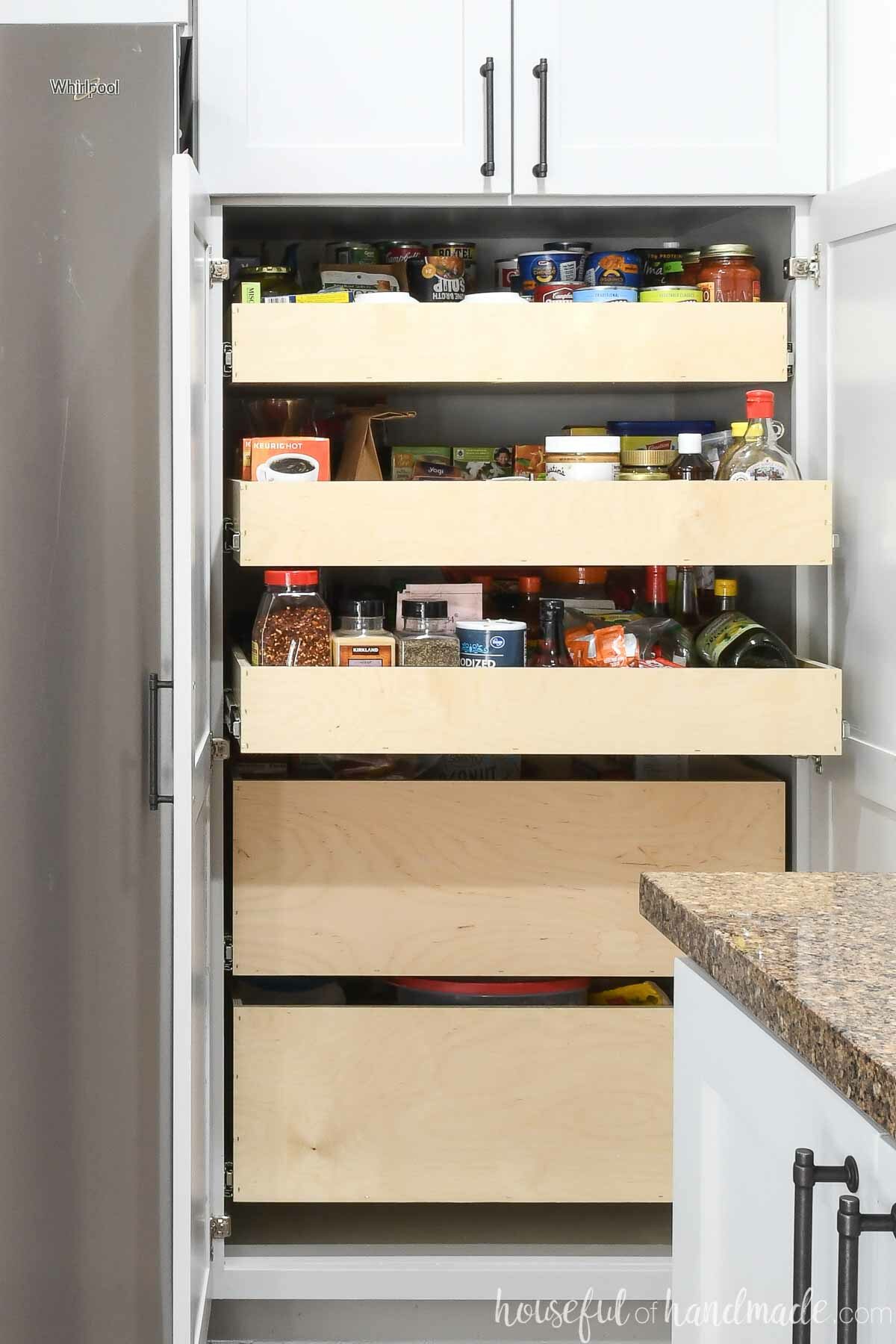
How deep is a pantry cabinet?
If your pantry cabinet is next to a base cabinet, I recommend you build it the same depth as your base cabinets.
However, if your pantry cabinet is next to a refrigerator, you can build your cabinet deeper to match. That is what I did in my first DIY kitchen remodel.
Refrigerators typically come in two depth options: standard or counter depth. The standard option is usually slightly deeper than 30″ installed.
So if doing pantry cabinets around, or next to, a standard depth fridge, I like to make them 30″ deep.
If you are building your cabinets by a cabinet depth fridge, stick to the standard 24″ base cabinet depth.
Lastly, if your pantry cabinets are not up against any other cabinets or a fridge, you can make them any depth you prefer. That is the beauty of DIY!
A wall of 18″ pantry cabinets would give you 6″ deeper cabinets than standard wall cabinets, but make things easier to find then in deeper cabinets.
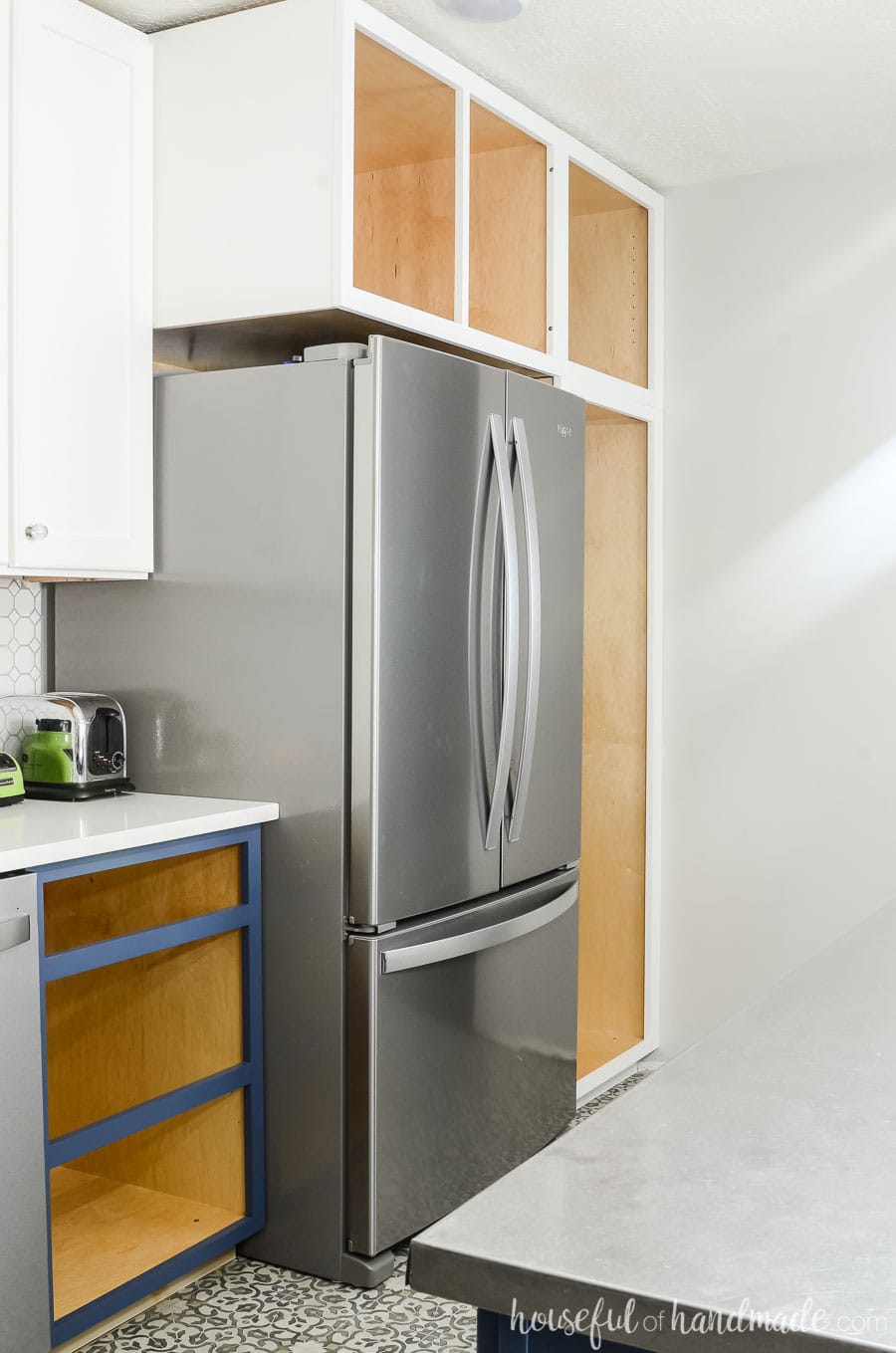
Do pantry cabinets need a toe kick?
A toe kick is a cut out at the bottom of a base cabinet that allows for you to get closer to the cabinet because your feet have a space to go. Toe kicks also bring your cabinet opening up off the floor a few inches.
Since your pantry cabinet does not have a countertop for you to stand up to, a toe kick is not necessary.
But you would still want to raise the cabinet opening up off the floor a couple inches to make sure your cabinets can open easily without getting caught on carpet or other items that might be on the floor.
If your pantry is touching other kitchen base cabinets. It is recommended that you match the toe kick from the base cabinet for continuity.
If your pantry cabinet is separated from the other cabinets, you can skip the toe kick and use a kickboard instead.

A kickboard is a piece of wood around the base of the cabinet, similar to a baseboard on your wall. It covers up the area below the bottom shelf.
You can learn about different toe kick options and size recommendations in the how to build base cabinets guide.
Pantry Cabinet Plans
Once you have figured out the answers to the questions above, it it time to create plans for your own pantry cabinet! I will walk you through how to create plans for your custom pantry cabinets and so you will be ready to start building.

Each pantry cabinet will have the following parts:
- 2 lower side pieces
- 2 upper side
- 4 top/bottom pieces
- 1 lower back piece
- 1 upper back piece
- 2 support pieces
- Optional: toe kick or kickboard
- Optional: face frame
- 2 lower face frame stiles
- 2 upper face frame stiles
- 4 face frame rails
- Optional: shelves or drawers
To build your pantry cabinets, you will want to use 3/4″ plywood for most of the cabinet box. I recommend using 1/4″ plywood for the back and toe kick cover (if using) to save money and make your box lighter.
To finish off the front of the plywood edges, you will need to either use edge banding to create a frameless cabinet or a face frame to create a face frame cabinet.
Face frames are typically built from 1×2 boards (which are actually 3/4″ thick and 1 1/2″ wide). If you want a larger more noticeable frame, you can use wide boards.
Face Frame Pantry Cabinet Cut List
Use the following chart to figure out the dimensions for your all the pieces of your face frame pantry cabinet.
Or use the cut list calculator included in the PDF plans.
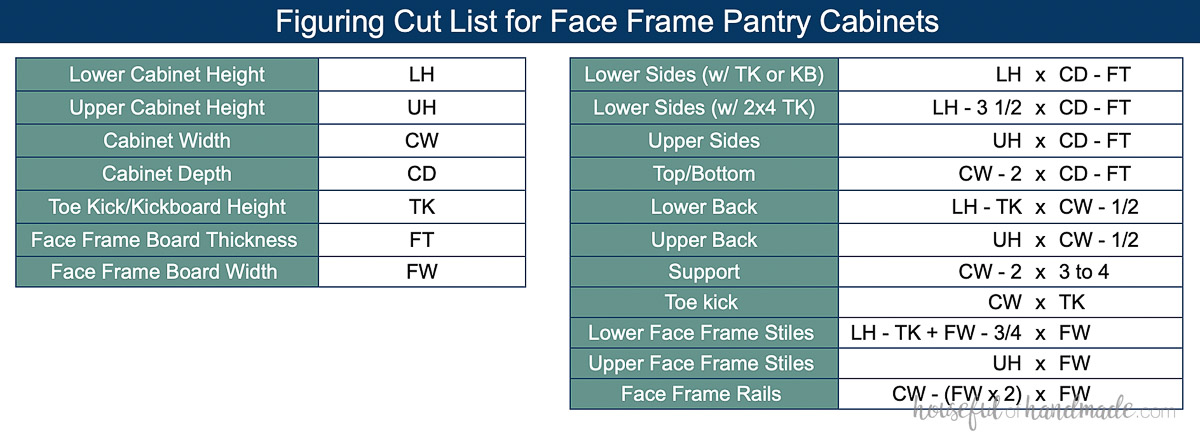
Important notes for face frame cabinets:
- The face frames hang over the sides of the cabinets 1/4″. This makes it easier to install, but if the side of your base cabinet is going be visible, you will need to add a side panel (use 1/4″ plywood and cut it the exact size of the base sides and tack it on) or adjust your measurements to make up for the 1/4″ extra on one side.
- The back panel is not set into the back with a groove, instead it is just nailed on. Because the cabinet is built in, you will only see the back panel if the side of a cabinet is visible. Fix this with the above mentioned panel (cut it 1/4″ deeper to cover the back panel) or router in grooves and adjust the back panel size to fit in those grooves.
Once you figure out the dimensions for all you pieces, you will need to cut them out. Learn how to easily cut plywood with a circular saw here.
Frameless Pantry Cabinet Cut List
Use the following chart to figure out the dimensions for your all the pieces of your frameless pantry cabinet.

Important notes for frameless cabinets:
- Plywood is not actually 3/4″ thick, it is slightly smaller. And not all plywood is the exact same. I would recommend you tightly press two pieces of the plywood you are using together and measure it. You can substitute this measurement for the 1 1/2″ you subtract for the bottom and support pieces. This will give you more exacting cabinet widths.
- The back panel is not set into the back with a groove, instead it is just nailed on. Because the cabinet is built in, you will only see the back panel if the side of a cabinet is visible. If you are going to have visible cabinet sides, router in grooves and adjust the back panel size to fit in those grooves.
How to Build a Pantry Cabinet Box
Tools & Materials
Recommended Tools:
- Circular saw with guide track or Table saw
- Miter saw
- I recently upgraded to this larger sliding miter saw (watch for it to go on sale), but all my projects before were built with this inexpensive miter saw that I loved.
- Pocket hole jig
- Drill
- Impact driver (optional, but I love not having to switch bits with the drill)
- Squares
- Measuring tape
- Clamps
- Right angle clamps and face frame clamps are super helpful
I go into detail on how to build cabinets without expensive tools here. These were all the tools I used to build my first kitchen cabinets.
Supplies:
- Wood products:
- 3/4″ plywood
- 1/4″ plywood
- Optional: 1x boards for face frame cabinets
- Optional: Plywood edge banding for frameless cabinets
- Optional: 2×4 boards for toe kick base
- Wood glue
- If using pre-finished plywood, use melamine glue to get strong joints.
- 1 1/4″ pocket hole screws
STEP 1- Cut out the pieces
Cut out your pieces according to the cut list you determined above. Or use the cut list calculator that comes with the PDF build plans.
If you are building your lower cabinet with a toe kick, use a circular saw, jig saw, or band saw to cut it out of the front of both side boards.
If doing a 2×4 base for the lower cabinet, you do not need to notch out the sides, instead they are cut 3 1/2″ shorter to allow for the cabinet to sit on top of it.
If using a kickboard or for the upper pantry cabinet, leave the cabinet sides un-notched.
Drill pocket holes set for 3/4″ material in the sides of the top and bottom pieces. You need to have pocket holes every 4-5 inches for strong cabinet boxes.
For frameless cabinets, iron on the edge banding to the front off all the pieces before assembly.
For face frame cabinets: also drill pocket holes in the front of the top, bottom and both side pieces.
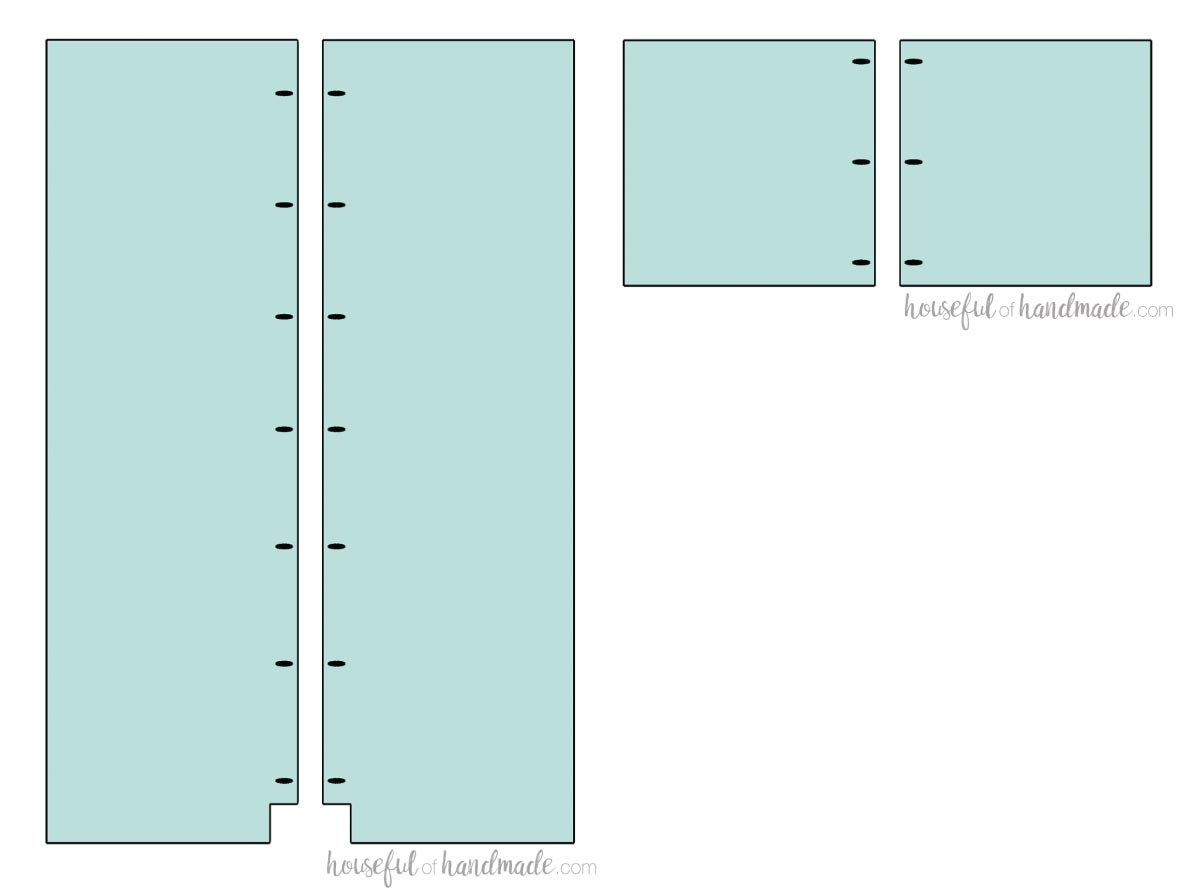
STEP 2- Assemble the Cabinet Box
Make sure to read the Tips for a Perfect Cabinet Box section in this post for helpful tips.
For the lower cabinet, line the bottom piece up with the top of the toe kick or kickboard (or bottom of the side board if doing a 2×4 base for the toe kick).
Secure with wood glue and pocket hole screws. Use corner clamps to make sure the piece is joined at a 90 degree angle.
Then attach the top so it is flush with the top of the sides.
For the upper pantry cabinet, the bottom piece will be set up from the bottom of the sides so the top of the shelf is flush with the top of the face frame. So if you have a 1 1/2″ wide face frame, you will attach the bottom so the top of it is 1 1/2″ up from the bottom of the sides.
Frameless upper cabinets will have the bottom flush with the bottom of the sides.
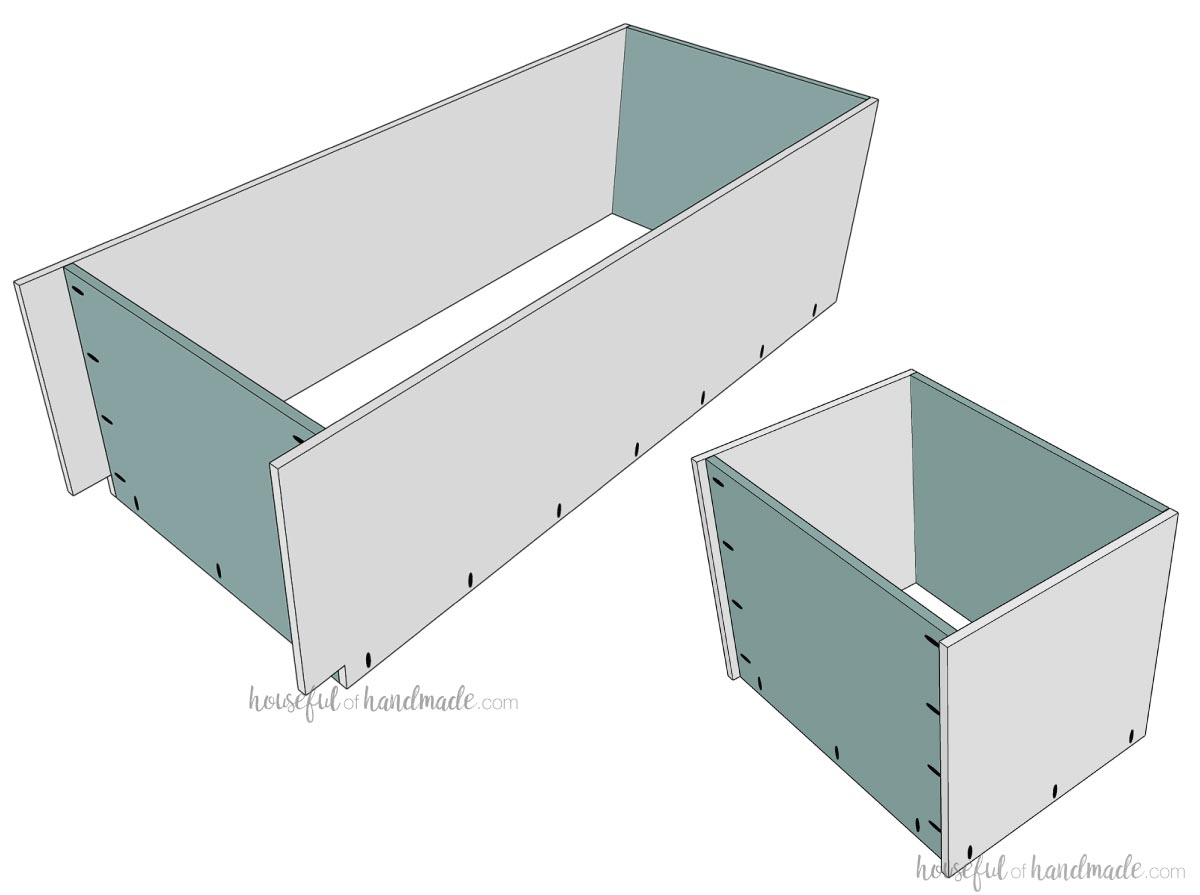
Attach the support piece. These will be where you will attach the cabinet to the wall. Use scraps of plywood to cut them. They can be 3-4″ thick.
The support will be on the back of the box along the top just under the top piece. Attach it with pocket holes using 1 1/4″ pocket hole screws.
I like to attach it to the top piece with a couple pocket holes along the edge as well.
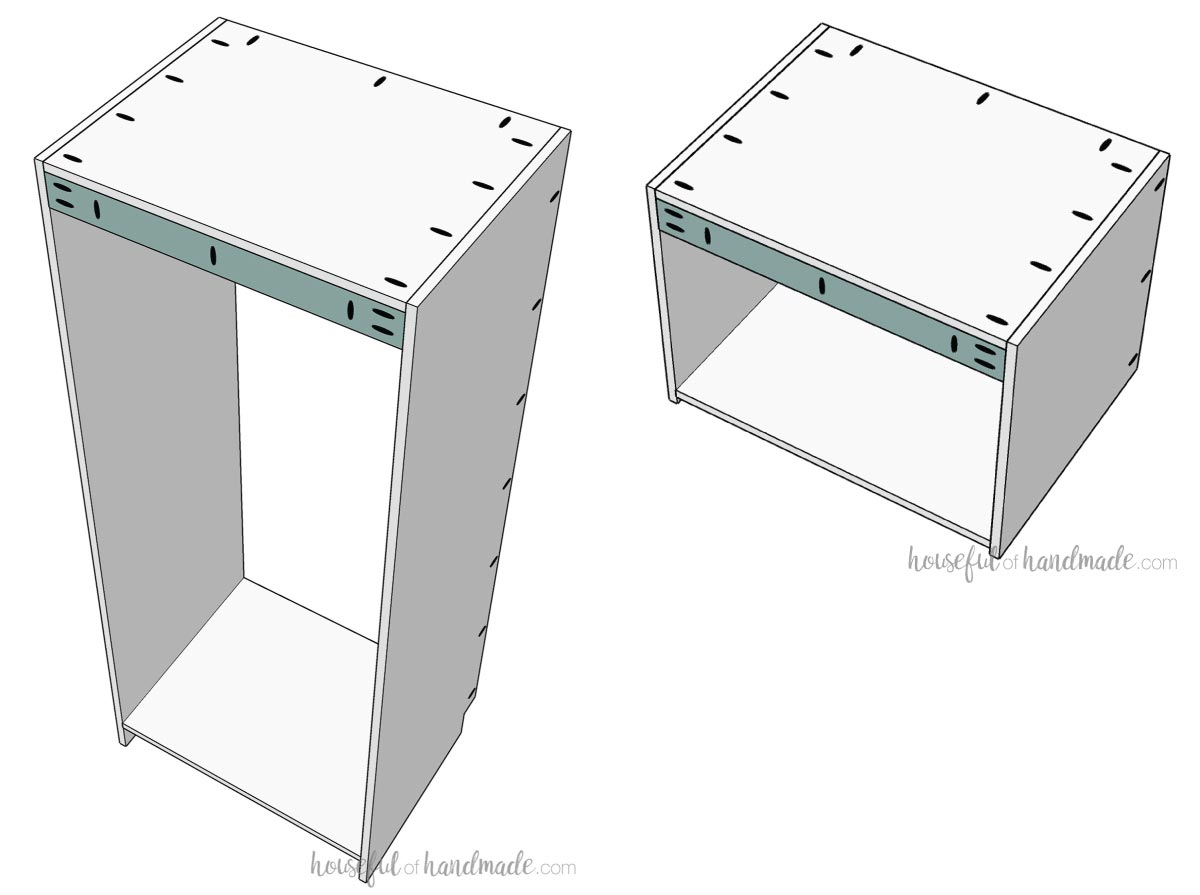
Attach the back with wood glue and finishing nails.
If the sides of your cabinet are going to be visible, you may want to router a groove into the back to set the panel inside. Or you can make a side panel slightly bigger to cover the sides and back panel together.
If you do not want to see the support pieces inside your cabinet, you can add the back panel in front of them. But I find the supports blend in nicely with the back of the cabinet. And you only see it with the doors open.
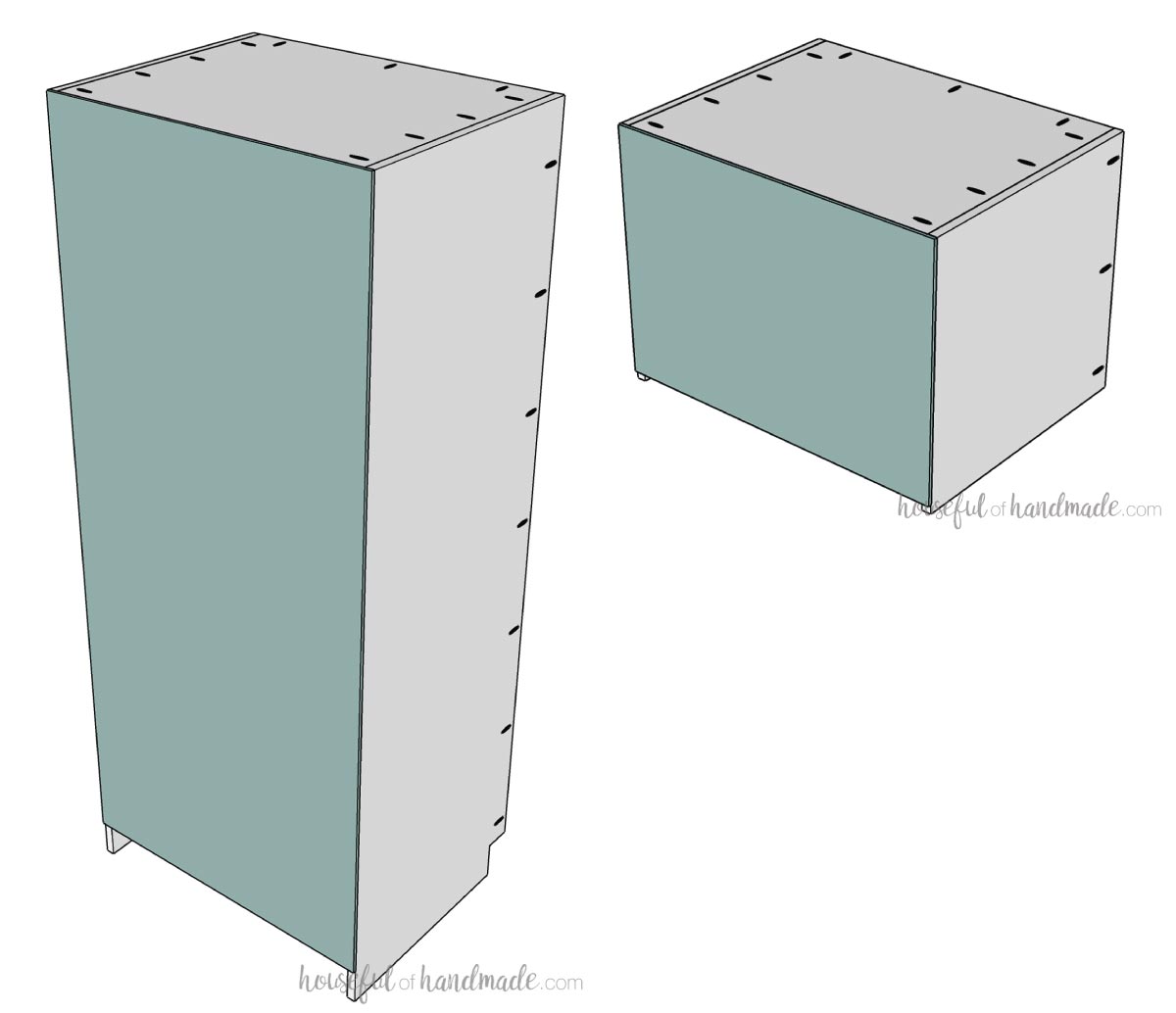
Also, you can cut and attach the toe kick/kickboard front now. Or better yet, cut it large to cover an entire bank of cabinets.
Now your base cabinet carcass is all done!
For face frame cabinets, proceed to the next steps. For frameless, skip to Step 4.
STEP 3- Assemble the Face Frame
Cut the rails and stiles for your face frame. Drill pocket holes set for 3/4″ material in each end of the rails.
Attach the rails between the stiles so they are flush with the top and bottom. Use wood glue and 1 1/4″ pocket hole screws.
Use a face frame clamp to keep the frame front flush and tight while attaching them.

Now the face frame is ready to attach to the front of your cabinet box.
The face frame will need to sit 1/4″ over each side of the cabinet. Also make sure the top is flush with the top of the cabinet box.
Also, the top of the bottom rail will be flush with the top of the bottom shelf.
Add a bit of wood glue to the front of the plywood, then use the pocket holes you already drilled in the sides and base of the cabinet to secure the face frame with 1 1/4″ pocket hole screws.
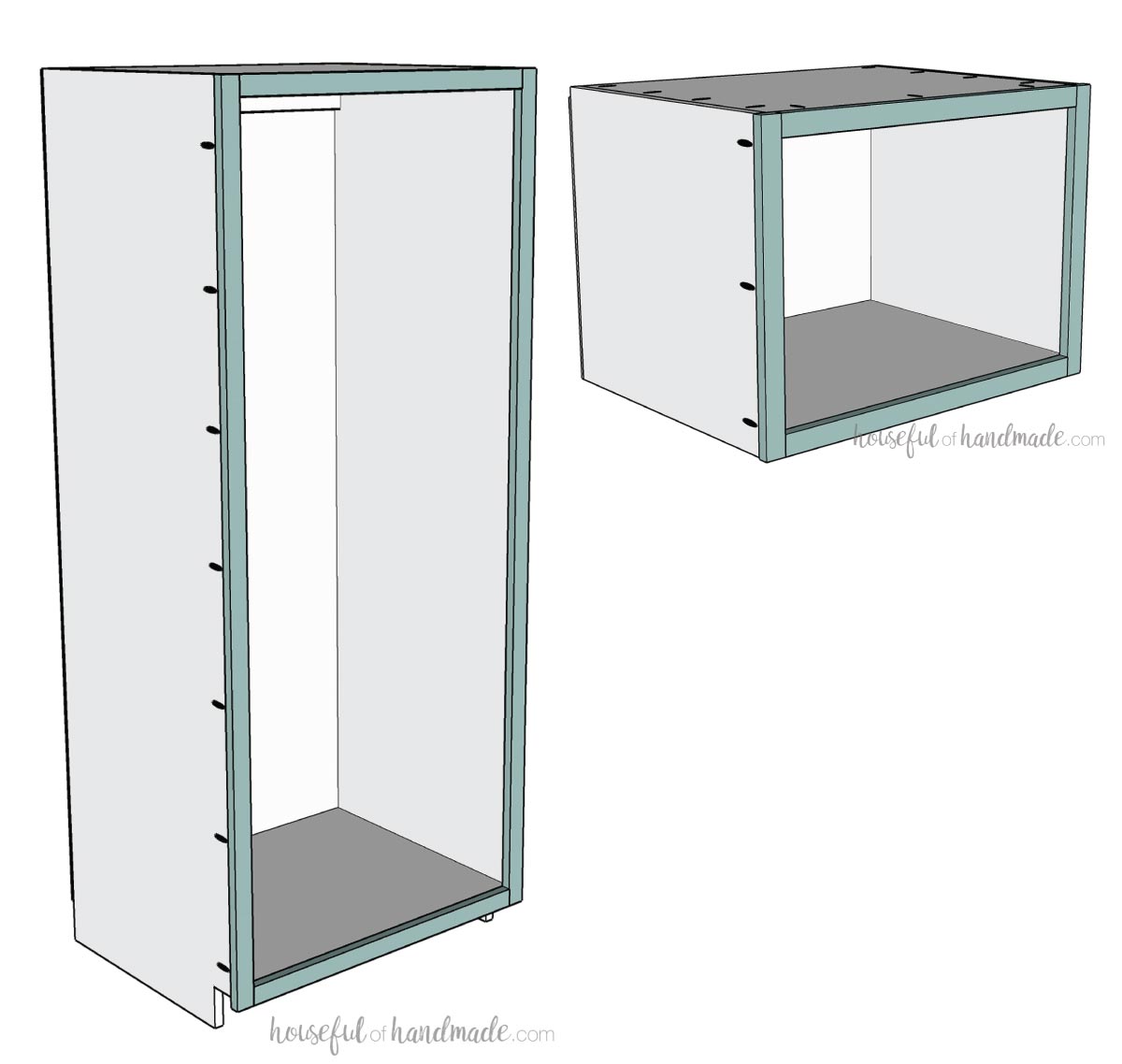
Alternately, you can attach the face frame with 1 1/4″ brad nails. Then will need to fill the nail holes before painting. This is not recommended for stained cabinets.
STEP 4- Add Shelves or drawers
To make the most of the space inside your pantry cabinet, you will want to add adjustable shelves, drawers, or a combination of the two.
Learn how to build drawers for your pantry here.
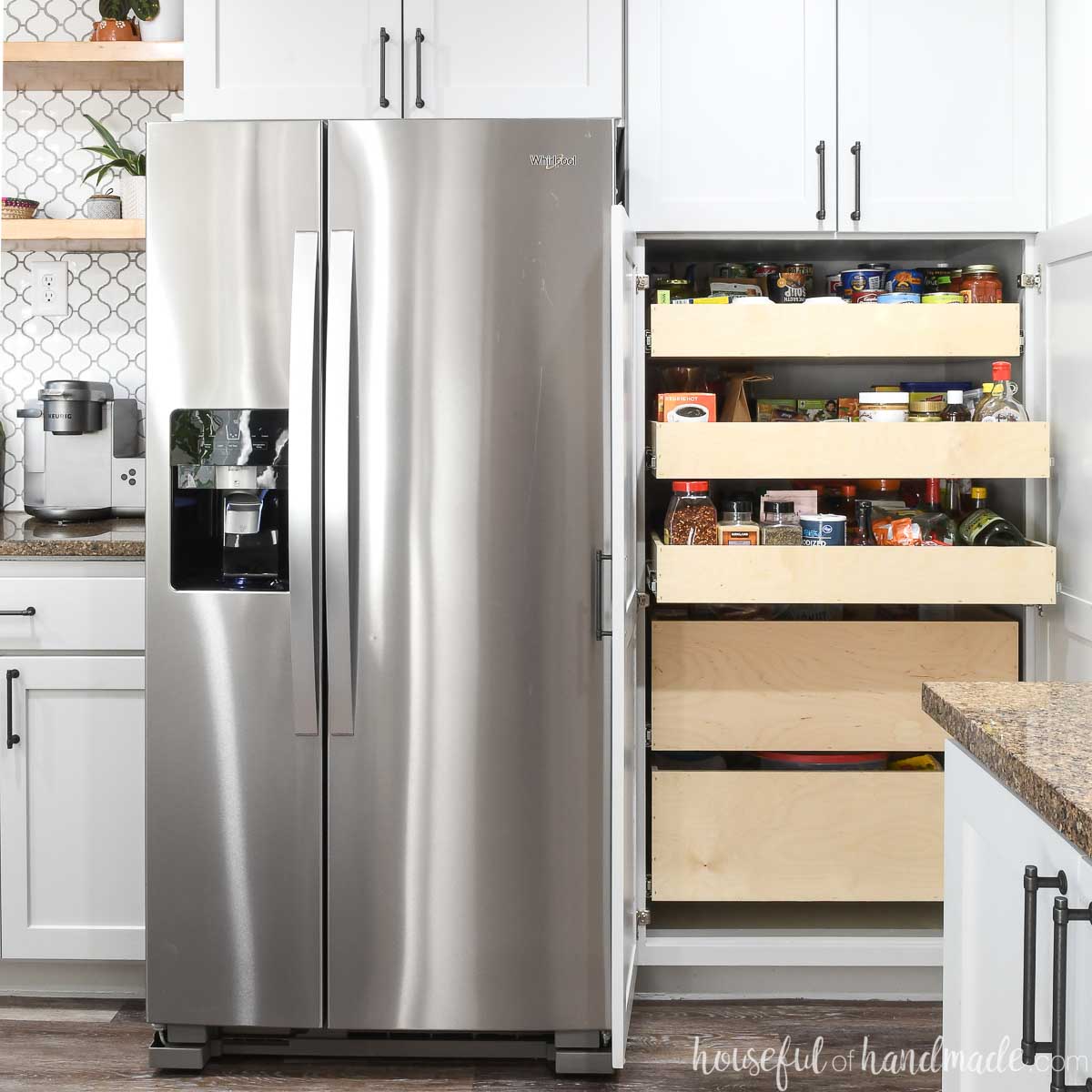
There are many ways to add adjustable shelves to your DIY cabinets. But I have found the easiest and most cost effective way is to use shelf pins with a simple shelf pin jig.
I use the Kreg shelf pin jig to quickly add holes for shelf pins. There are two different bits for the jig (5mm and 1/4″) so make sure to check that you have the correct sized pins for your bit (or buy both).
There are many different types of shelf pins, anywhere from a straight cylinder to and L. I prefer the L shaped pins. The shelf helps to hold the pins in the sides of cabinet and my shelves are very secure.
When drilling holes, don’t bother drilling holes in the bottom and top approximately 6″ unless you have a need for a very short shelf area. Instead, use a scrap of wood as a spacer on the bottom of the shelf pin jig to ensure the holes for the pins stay even across all 4 rows.
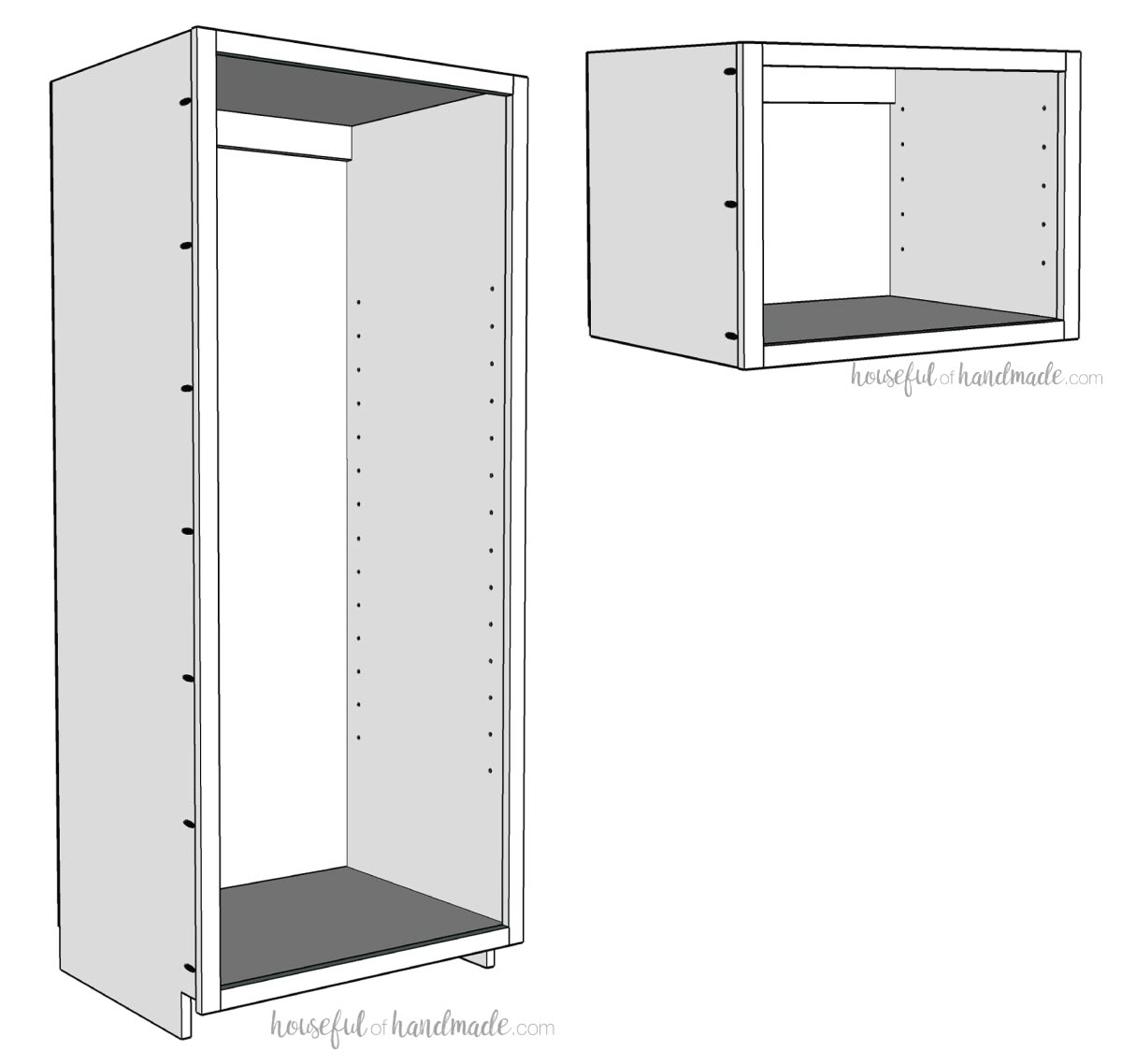
STEP 5- Add doors
Door are necessary to finish off the pantry box. They keep things hidden, as well as keeping them clean and dust free.
There are many different kinds of doors you can build for your cabinets. But before deciding on style, it is important to understanding cabinet door sizes and hinges.
Once you have determined the cabinet door sizes, you can build your own DIY shaker style cabinet doors or easy slab cabinet doors from plywood. Or you can also build glass panel cabinet doors for added style.
Once your doors are built, install your doors with concealed hinges with this tutorial.

To add drawers to your pantry, you can learn how to build easy DIY drawers 3 ways here. Then learn to install cabinet doors here.
Your cabinet is now ready to install.
Premium cabinet plans include:
- Recommended Tools
- Shopping list
- How to figure cut list for custom cabinets
- Step-by-step instructions with 3D renderings
- Plywood layout tips and examples
- Cabinet making tips & techniques
- Helpful resources
- BONUS: Cabinet cut list calculator
- BONUS: Cut lists for standard sized cabinets
- BONUS: 3D SketchUp file of basic cabinet
Tips for a Professional Cabinet that are Easy to Install
1- Router tiny chamfers on the side edges of the face frames. That way, if the cabinets do not sit perfectly flush during install, it is not as obvious.
2- For any exposed sides of cabinets, you will want to cut 1/4″ panels to cover the sides. This will hide the pocket holes and make the side of the face frame flush with the cabinet.
3- Cut the toe kick panel to cover an entire section of cabinets instead of individual cabinets to eliminate another edge that needs to be lined up perfectly.
4- Build your cabinet box with pre-finished plywood, then all you have to do is paint/finish the face frames to have your cabinets ready to install. See how to get a smooth professional paint finish on your cabinets.
5- Add a center stile for large base cabinets to give extra support to the center and make installing cabinet doors easier (no need to stress about the center reveal as much).
And if there are any questions or things I forgot, send me a message and I will do my best to answer. I want to give you the confidence to build your own cabinets too!


